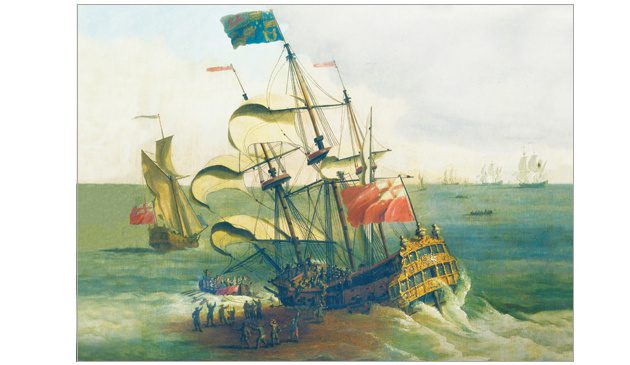The New River

Over the centuries water continued to flow along the New River from Hertfordshire to Islington. New River Head became a favourite place for Londoners to take a walk, a pleasant spot from where they could gaze down over the entire metropolis, from Mile End in the east to Westminster in the west and Southwark in the south. It was most probably in 1665 that the artist and engraver Wenceslaus Hollar escaped to Islington from the plague-ridden London and whilst there sketched evocative pictures of New River Head. In around 1750 the Venetian artist Canaletto sat on Islington Hill to take in the incredible panorama and produce one his celebrated London views, with the New River reservoirs in the foreground.
In 1759 a competition was held to design a new bridge over the Thames at Blackfriars. All the famous architects of the time submitted plans but against the odds the chosen entry was by an unknown Scottish design student. His name was Robert Mylne. Propelled to fame by London’s new bridge, he went on to become a successor to Sir Christopher Wren as Surveyor to St.Paul’s Cathedral, the engineer of various canals and harbours, and the first of a dynasty of engineers to the New River Company. Such was Mylne’s dedication that he named his second son after one of the sources of the New River, at Chadwell. So we arrive at William Chadwell Mylne, the engineer responsible for the view from my window.
As London and its population grew during the early 19th century, as well as the demand for the New River Company’s water, William Chadwell Mylne recommended to the company’s Board the creation of two holding reservoirs beside the canal, north of the village of Stoke Newington. They were created between 1830 and 1833. London Bridge was being rebuilt at the same time to replace the one that had stood since 1759 (of which parts had survived since medieval times). Mylne used wood from the old bridge to line the reservoirs at Stoke Newington in order to protect the banks.
In the 1830s London was plagued by outbreaks of cholera but it took until the 1850s for John Snow, a doctor working in Soho, to realise the disease was being carried by the city’s dirty water supply. The Metropolis Water Act of 1852 stipulated that all water supplies brought by open aqueducts must be cleansed by filtering, and supply channels within five miles of St.Paul’s Cathedral must be covered. That affected the New River in two ways. Firstly, the previously open canal had to be covered for its final section into London, and secondly the water must be cleansed. Mylne recommended the creation of cleansing filter beds close to the Stoke Newington reservoirs and an engine-house to pump the filtered water through an underground iron pipe to a new covered reservoir at Claremont Square at Pentonville.
The pumping-house at Stoke Newington – the building I can see from my home – was designed by Mylne, assisted by Robert Billings, and inspired by Sterling Castle in Scotland. Drawings of it were exhibited at the Society of British Artists in 1856. It may seem a fanciful work but almost everything other than the battlements had a practical purpose. The main tower was a chimney, with others containing an iron standpipe and spiral staircases that gave access to the enormous engines. The buttresses are not structural but are hollow and contained the huge fly-wheels of six Boulton & Watt beam engines, each twenty-five feet in diameter, weighing thirty-five tons, powered by eighteen boilers and producing two hundred horsepower. They were so large that the building was erected around them. The buttresses are adorned with the monograms ‘MYLNE 1855’.
What of the New River today? The New River Company existed until 1904 when it was taken over by the Metropolitan Water Board. New River Head at Sadler’s Wells continued in use (latterly as filter-beds) well into the 20th century until being filled-in so the land could be used as offices and a laboratory for the Metropolitan Water Board. However, the nearby reservoir at Claremont Square, bordered by the busy Pentonville Road along one side, remains part of Thames Water’s water storage facilities. During the Second World War the pumping-house and reservoirs at Stoke Newington, which were still part of the water-supply system for London, were targets for German bombers. Luckily, they never scored a direct hit but did great damage to the surrounding areas, where council flats were built after the war. One reservoir is now used for sailing and canoeing and the other a protected nature reserve. After the war the pumping-house eventually fell into disuse. When the massive steam-engines were scrapped in 1952 they had to be cut into pieces to get them out of the building. The building itself was listed as Grade II in 1972, much to the annoyance of its then owners, the Metropolitan Water Board, who learnt about it in the Times newspaper. In 1995 the inside space was converted for use as a climbing centre and is now one of the most popular in London, known as ‘The Castle’. A statue of Hugh Myddelton stands on Islington Green at the junction of Upper Street and Essex Road and a number of streets, schools and buildings along the canal’s route are named after him. After four hundred years the New River continues to supply a significant amount of London’s water supply.
For those wanting to read more about the history of the New River I recommend London’s New River by Robert Ward (Historical Publications).
The New River makes for an interesting walk, which is detailed in Michael Essex-Lopresti’s Exploring the New River (Brewin Books).
This is an edited version of an article that was first published by London Historians, May 2011.


